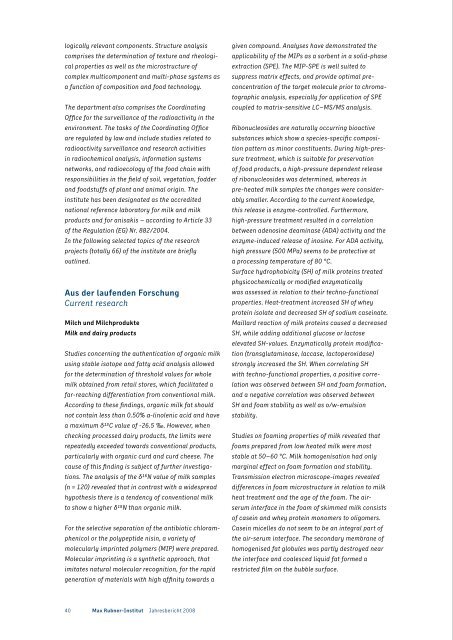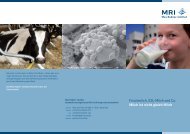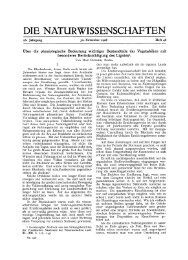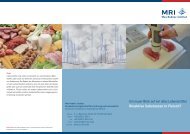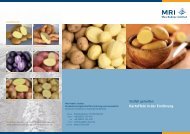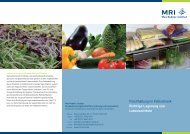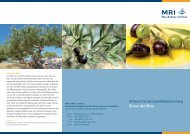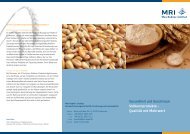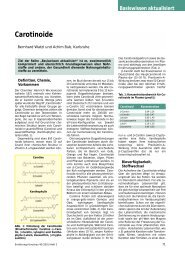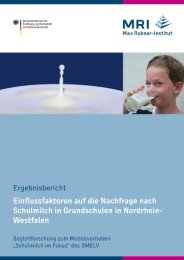Jahresbericht Annual Report 2008 - Max Rubner-Institut - Bund.de
Jahresbericht Annual Report 2008 - Max Rubner-Institut - Bund.de
Jahresbericht Annual Report 2008 - Max Rubner-Institut - Bund.de
Erfolgreiche ePaper selbst erstellen
Machen Sie aus Ihren PDF Publikationen ein blätterbares Flipbook mit unserer einzigartigen Google optimierten e-Paper Software.
logically relevant components. Structure analysis<br />
comprises the <strong>de</strong>termination of texture and rheological<br />
properties as well as the microstructure of<br />
complex multicomponent and multi-phase systems as<br />
a function of composition and food technology.<br />
The <strong>de</strong>partment also comprises the Coordinating<br />
Office for the surveillance of the radioactivity in the<br />
environment. The tasks of the Coordinating Office<br />
are regulated by law and inclu<strong>de</strong> studies related to<br />
radioactivity surveillance and research activities<br />
in radiochemical analysis, information systems<br />
networks, and radioecology of the food chain with<br />
responsibilities in the field of soil, vegetation, fod<strong>de</strong>r<br />
and foodstuffs of plant and animal origin. The<br />
institute has been <strong>de</strong>signated as the accredited<br />
national reference laboratory for milk and milk<br />
products and for anisakis – according to Article 33<br />
of the Regulation (EG) Nr. 882/2004.<br />
In the following selected topics of the research<br />
projects (totally 66) of the institute are briefly<br />
outlined.<br />
Aus <strong>de</strong>r laufen<strong>de</strong>n Forschung<br />
Current research<br />
Milch und Milchprodukte<br />
Milk and dairy products<br />
Studies concerning the authentication of organic milk<br />
using stable isotope and fatty acid analysis allowed<br />
for the <strong>de</strong>termination of threshold values for whole<br />
milk obtained from retail stores, which facilitated a<br />
far-reaching differentiation from conventional milk.<br />
According to these findings, organic milk fat should<br />
not contain less than 0.50% α-linolenic acid and have<br />
a maximum δBDC value of -26.5 ‰. However, when<br />
checking processed dairy products, the limits were<br />
repeatedly excee<strong>de</strong>d towards conventional products,<br />
particularly with organic curd and curd cheese. The<br />
cause of this finding is subject of further investigations.<br />
The analysis of the δBFN value of milk samples<br />
(n = 120) revealed that in contrast with a wi<strong>de</strong>spread<br />
hypothesis there is a ten<strong>de</strong>ncy of conventional milk<br />
to show a higher δBFN than organic milk.<br />
For the selective separation of the antibiotic chloramphenicol<br />
or the polypepti<strong>de</strong> nisin, a variety of<br />
molecularly imprinted polymers (MIP) were prepared.<br />
Molecular imprinting is a synthetic approach, that<br />
imitates natural molecular recognition, for the rapid<br />
generation of materials with high affinity towards a<br />
given compound. Analyses have <strong>de</strong>monstrated the<br />
applicability of the MIPs as a sorbent in a solid-phase<br />
extraction (SPE). The MIP-SPE is well suited to<br />
suppress matrix effects, and provi<strong>de</strong> optimal preconcentration<br />
of the target molecule prior to chromatographic<br />
analysis, especially for application of SPE<br />
coupled to matrix-sensitive LC–MS/MS analysis.<br />
Ribonucleosi<strong>de</strong>s are naturally occurring bioactive<br />
substances which show a spe cies-specific composi-<br />
tion pattern as minor constituents. During high-pres-<br />
sure treatment, which is suitable for preservation<br />
of food products, a high-pressure <strong>de</strong>pen<strong>de</strong>nt release<br />
of ribonucleosi<strong>de</strong>s was <strong>de</strong>termined, whereas in<br />
pre-heated milk samples the changes were consi<strong>de</strong>rably<br />
smaller. According to the current knowledge,<br />
this release is enzyme-controlled. Furthermore,<br />
high-pressure treatment resulted in a correlation<br />
between a<strong>de</strong>nosine <strong>de</strong>aminase (ADA) activity and the<br />
enzyme-induced release of inosine. For ADA activity,<br />
high pressure (500 MPa) seems to be protective at<br />
a processing tempera ture of 80 °C.<br />
Surface hydrophobicity (SH) of milk proteins treated<br />
physicochemically or modified enzymatically<br />
was assessed in relation to their techno-functional<br />
properties. Heat-treatment increased SH of whey<br />
protein isolate and <strong>de</strong>creased SH of sodium caseinate.<br />
Maillard reaction of milk proteins caused a <strong>de</strong>creased<br />
SH, while adding additional glucose or lactose<br />
elevated SH-values. Enzymatically protein modification<br />
(transglutaminase, laccase, lactoperoxidase)<br />
strongly increased the SH. When correlating SH<br />
with techno-functional properties, a positive corre -<br />
lation was observed between SH and foam formation,<br />
and a negative correlation was observed between<br />
SH and foam stability as well as o/w-emulsion<br />
stability.<br />
Studies on foaming properties of milk revealed that<br />
foams prepared from low heated milk were most<br />
stable at 50–60 °C. Milk homogenisation had only<br />
marginal effect on foam formation and stability.<br />
Transmission electron microscope-images revealed<br />
differences in foam microstructure in relation to milk<br />
heat treatment and the age of the foam. The airserum<br />
interface in the foam of skimmed milk consists<br />
of casein and whey protein monomers to oligomers.<br />
Casein micelles do not seem to be an integral part of<br />
the air-serum interface. The secondary membrane of<br />
homogenised fat globules was partly <strong>de</strong>stroyed near<br />
the interface and coalesced liquid fat formed a<br />
restricted film on the bubble surface.<br />
Physical properties of different commercial processed<br />
cheeses could be well characterized by oscillation<br />
rheometry. The results correspon<strong>de</strong>d to sensory<br />
texture profiles. Electron microscopic images showed<br />
specific microstructural features. The effect of<br />
emulsifying salts with different compositions on the<br />
properties of cheese analogues containing rennet<br />
casein and butter was analysed in the same way. These<br />
experiments aim at the replacement of sodium by<br />
potassium in or<strong>de</strong>r to improve the nutritional quality<br />
of such products.<br />
Arbeiten zur Authentifizierung von Bio-Milch durch<br />
Messung von Stabilisotopen und Fettsäuren erlaubten<br />
die Festlegung von Schwellenwerten für Vollmilch aus<br />
<strong>de</strong>m Einzelhan<strong>de</strong>l, die eine weitgehen<strong>de</strong> Unterscheidung<br />
von konventioneller Milch ermöglichen. Danach<br />
sollte das Bio-Milchfett min<strong>de</strong>stens 0,50% α-Linolensäure<br />
enthalten und einen δBDC-Wert von maximal<br />
-26,5‰ aufweisen. Allerdings zeigte die Überprüfung<br />
an verarbeiteten Milchprodukten insbeson<strong>de</strong>re bei<br />
Bioquark und -frischkäse wie<strong>de</strong>rholt Über- bzw.<br />
Unterschreitungen <strong>de</strong>r Werte in Richtung konventioneller<br />
Milchprodukte, <strong>de</strong>ren Ursache Gegenstand<br />
weiterer Untersuchungen ist. Die Analyse <strong>de</strong>s δBFN-<br />
Wertes von Milch (n = 120) ergab, dass entgegen<br />
allgemeiner Erwartungen konventionelle Milch ten<strong>de</strong>nziell<br />
ein höheres δBFN-Niveau als Bio-Milch<br />
aufweist.<br />
Zur selektiven Separation <strong>de</strong>s Antibiotikums Chloram-<br />
phenicol und <strong>de</strong>s Polypeptids Nisin wur<strong>de</strong>n molekular<br />
geprägte Polymere (MIP) synthetisiert. Die molekulare<br />
Prägung ist eine Metho<strong>de</strong> zur schnellen Generation<br />
von Materialien, die eine hohe Affinität gegenüber<br />
einer vorgegebenen Verbindung aufweisen, wobei <strong>de</strong>r<br />
Wie<strong>de</strong>rerkennungsprozess <strong>de</strong>m von Makrobiomolekülen<br />
wie Antikörpern o<strong>de</strong>r Enzymen ähnlich ist.<br />
Verschie<strong>de</strong>ne Untersuchungen zeigten, dass die MIPs<br />
für <strong>de</strong>n Einsatz als Sorbentien zur Festphasenextraktion<br />
(SPE) geeignet sind. Die MIP-SPE ermöglicht eine<br />
optimale Abtrennung von <strong>de</strong>r Probenmatrix sowie<br />
Konzentrierung <strong>de</strong>s Zielanalyten vor einer chromatographischen<br />
Analyse, insbeson<strong>de</strong>re zur Anwendung<br />
<strong>de</strong>r SPE in Verbindung mit Matrix-sensitiver instrumenteller<br />
Analytik wie LC–MS/MS.<br />
Ribonucleosi<strong>de</strong> sind natürlich vorkommen<strong>de</strong> bioaktive<br />
Substanzen, die als minore Inhaltsstoffe in Milch ein<br />
Spezies-spezifisches Gehalts muster zeigen. Bei Hoch-<br />
druck-Behandlung, die z.B. zum Konservieren von<br />
Lebensmitteln geeignet ist, traten in Rohmilch proben<br />
Hochdruck-abhängige Ribonucleosid-Freisetzungen<br />
40 <strong>Max</strong> <strong>Rubner</strong>-<strong>Institut</strong> <strong>Jahresbericht</strong> <strong>2008</strong> 41 <strong>Institut</strong> für Sicherheit und Qualität bei Milch und Fisch<br />
auf, wohingegen in ther misch vorbehan<strong>de</strong>lten<br />
Milchproben die Gehaltsverän<strong>de</strong>rungen wesentlich<br />
geringer waren. Nach <strong>de</strong>r zeitigem Kenntnisstand sind<br />
diese Freisetzungen Enzym-gesteuert. Weiterhin<br />
zeigte die Hochdruckbehandlung einen Zusammenhang<br />
zwischen <strong>de</strong>r Aktivität <strong>de</strong>r A<strong>de</strong>nosin<strong>de</strong>saminase<br />
(ADA) und <strong>de</strong>n Gehalten <strong>de</strong>s enzymatischen Produkts<br />
Inosin. Für ADA scheint Hochdruck (500 MPa) bei<br />
80 °C Prozesstemperatur protektiv zu sein.<br />
Die Oberflächen-Hydrophobizität (OH) chemischphysikalisch<br />
o<strong>de</strong>r enzymatisch behan<strong>de</strong>lter Milchproteine<br />
wur<strong>de</strong> in Relation zu <strong>de</strong>n technofunktionellen<br />
Eigenschaften untersucht. Eine Wärmebehandlung<br />
erhöhte die OH von Molkenproteinisolat und verringerte<br />
die von Natriumcaseinat. Die Maillard-Reaktion<br />
von Milchproteinen führte zu einer geringeren OH,<br />
wohingegen die Zugabe von Glucose o<strong>de</strong>r Lactose<br />
erhöhte Werte erbrachte. Eine enzymatische Proteinmodifizierung<br />
(Transglutaminase, Lactase, Laktoperoxydase)<br />
führte zu einer wesentlichen Erhöhung <strong>de</strong>r<br />
OH. Es konnte eine positive Korrelation zwischen <strong>de</strong>r<br />
OH und <strong>de</strong>m Schaumvolumen und eine negative<br />
Korrelation zwischen <strong>de</strong>r OH und <strong>de</strong>r Schaum- beziehungsweise<br />
<strong>de</strong>r Emulsionsstabilität beobachtet<br />
wer<strong>de</strong>n.<br />
Untersuchungen zu Schaumbildungseigenschaften<br />
<strong>de</strong>r Milch ergaben, dass gering erhitzte Milch, die bei<br />
50–60 °C aufgeschäumt wur<strong>de</strong>, sehr stabil war. Die<br />
Homogenisierung hatte nur einen geringen Effekt auf<br />
die Schaumbildungseigenschaften. Transmissionselektronenmikroskopische-Bil<strong>de</strong>r<br />
(TEM) zeigten in<br />
Abhängigkeit <strong>de</strong>r Milcherhitzung und <strong>de</strong>s Alters <strong>de</strong>r<br />
Schäume Unterschie<strong>de</strong> in <strong>de</strong>r Mikrostruktur. Die<br />
Grenzfläche von Magermilchschäumen besteht aus<br />
Casein- und Molkenprotein-Monomeren und Oligomeren.<br />
Caseinmicellen scheinen nicht integraler<br />
Bestandteil <strong>de</strong>r Grenzfläche zu sein. Die Sekundärmembran<br />
aus homogenisierten Fettkügelchen wur<strong>de</strong><br />
an <strong>de</strong>r Grenzfläche partiell zerstört und das koaleszierte<br />
flüssige Fett bil<strong>de</strong>te einen Film auf <strong>de</strong>r Luftblasenoberfläche.<br />
Mit Hilfe <strong>de</strong>r Oszillationsrheometrie ließen sich die<br />
physikalischen Eigenschaften unterschiedlicher<br />
Schmelzkäseprodukte aus <strong>de</strong>m Han<strong>de</strong>l charakterisieren.<br />
Die Ergebnisse korrespondierten mit <strong>de</strong>n<br />
sensorisch ermittelten Texturprofilen. Mikrostrukturelle<br />
Beson<strong>de</strong>rheiten konnten elektronen mikro-<br />
skopisch gezeigt wer<strong>de</strong>n. Mit gleicher und ergänzen-<br />
<strong>de</strong>r Analytik wird auch <strong>de</strong>r Einfluss unterschiedlicher<br />
Schmelzsalzzusammensetzungen auf die Eigenschaf-


